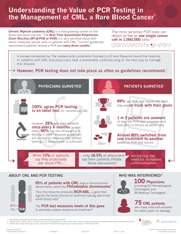Many people with CML do not have symptoms when diagnosed. The most common sign of CML is an abnormal white blood cell count often found during blood tests for an unrelated health problem or during a routine checkup. To diagnose CML, doctors use a variety of tests to analyze blood and bone marrow cells. A pathologist, a doctor who specializes in identifying diseases by studying cells under a microscope, will examine the blood cells and the bone marrow cells. The samples should also be examined by a hematopathologist, a specialist who diagnoses diseases of the blood and marrow.
Tests Used To Diagnose CML
Complete Blood Count (CBC) with Differential. This test is used to measure the number red blood cells, white blood cells and platelets in a sample of blood. It also measures the amount of hemoglobin in the red blood cells and the percentage of red blood cells in the sample. The CBC should include a differential. The differential measures the different types of white blood cells in the sample.
People with CML often have:
- An increased white blood cell count, often a very high level
- A decreased red blood cell count
- A possible increase or decrease in the number of platelets, depending on the severity of the disease
Peripheral Blood Smear. Blood cells are stained (dyed) and examined with a light microscope. These samples show:
- The number, size, shape and type of blood cells
- Specific pattern of white blood cells
- The proportion of immature cells (blast cells) compared to the proportion of maturing and fully matured white blood cells.
Blast cells are normally not present in the blood of healthy individuals.
Bone Marrow Aspiration and Biopsy. These tests are used to examine bone marrow cells to find abnormalities, and are generally done at the same time. The sample is usually taken from the patient’s hip bone after medicine has been given to numb the skin. For a bone marrow aspiration, a hollow needle is inserted through the hip bone and into the bone marrow to remove a liquid sample of cells. For a bone marrow biopsy, a wider needle is used to remove a small piece of bone that contains marrow. Both samples are examined under a microscope to look for chromosomal and other cell changes.
To view an interactive 3D image to help you visualize and better understand the procedure, click here.
Cytogenetic Analysis. Cytogenetics is the study of chromosomes and chromosomal abnormalities. In these tests, special stains are applied to a bone marrow sample and then the cells are examined for chromosomal changes or abnormalities, such as the Philadelphia (Ph) chromosome. The presence of the Ph chromosome in the bone marrow cells, along with a high white blood cell count and other characteristic blood and bone marrow test findings, confirm the diagnosis of CML. In about 95 percent of people with CML, the Ph chromosome in bone marrow cells is detectable by cytogenetic analysis. In a small percentage of people with clinical signs of CML, the Ph chromosome cannot be detected by cytogenetic analysis. However, these patients almost always test positive for the BCR::ABL1 fusion gene on chromosome 22, found with the other types of tests, such as FISH and qPCR (see below).
Fluorescence In Situ Hybridization (FISH). This laboratory test is used to examine genes and chromosomes in cells. It is a slightly more sensitive method for detecting CML than the standard cytogenetic tests used to identify the Ph chromosome. FISH tests can identify the presence of the BCR::ABL1 gene.
Quantitative Polymerase Chain Reaction (qPCR). The qPCR test is the most sensitive test used to detect and measure the quantity of the BCR::ABL1 gene in blood or bone marrow samples. It can detect very small amounts of the BCR::ABL1 gene, even when the Ph chromosome cannot be detected in blood or bone marrow cells with cytogenetic testing. It is capable of detecting one CML cell among 100,000 normal cells.
See what doctors and patients say about the value of PCR testing:
Related Links
- Download or order The Leukemia & Lymphoma Society's free booklets
- Blood Tests
- Understanding Blood Counts
- Bone Marrow Tests

